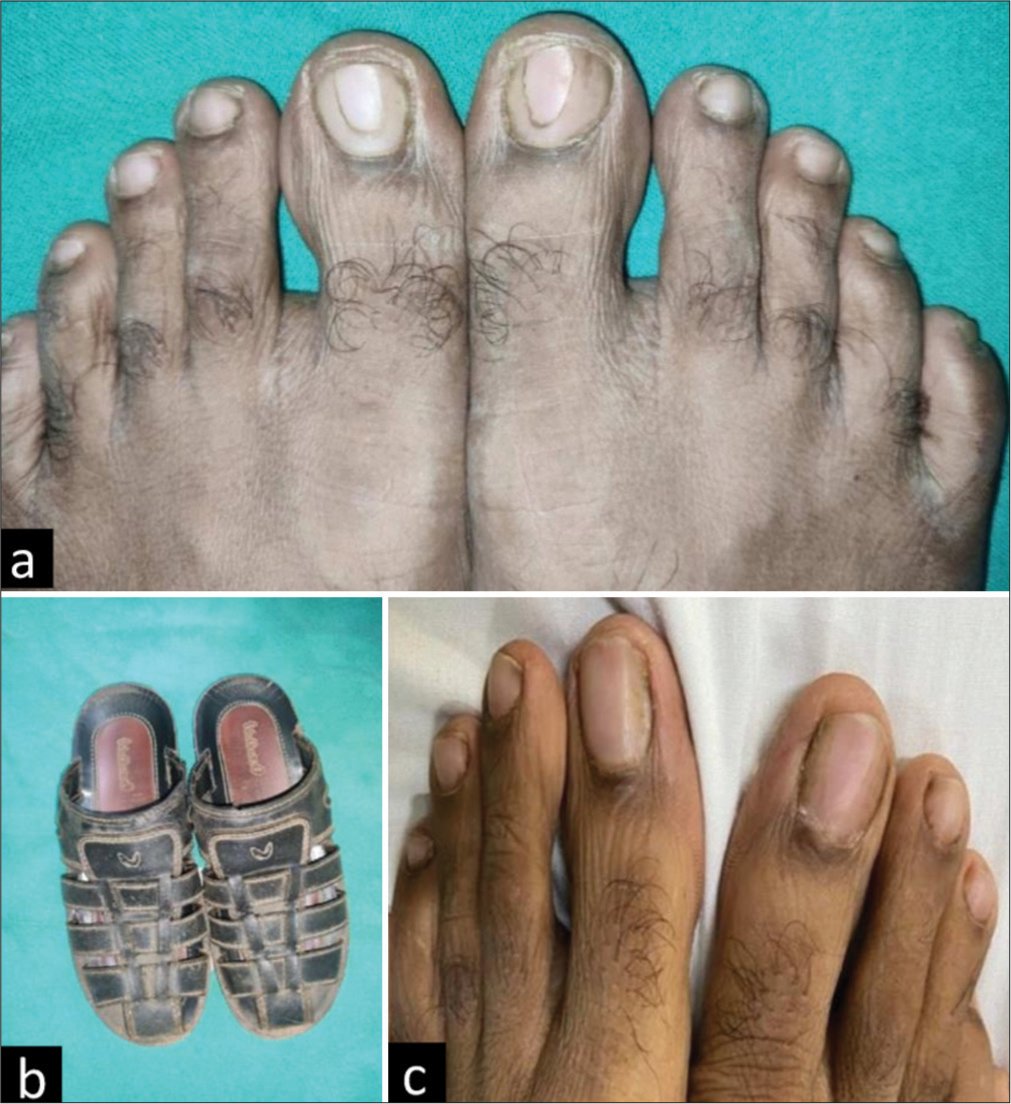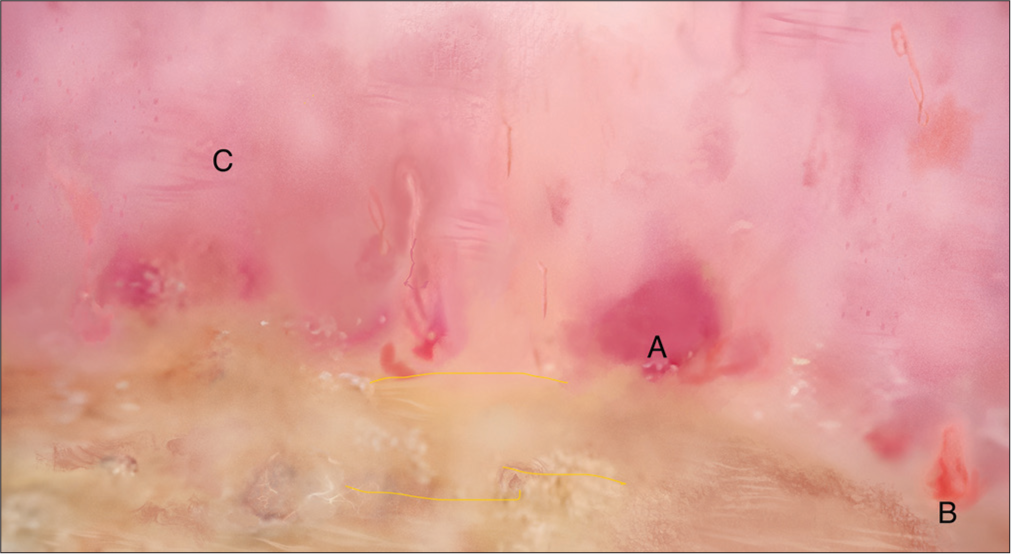Translate this page into:
Worn-Down Nails: A Rare Entity
*Corresponding author: Sakshi Gaba, Department of Dermatology, Kalinga Institute of Medical Science, KIIT University, Bhubaneswar, Odisha, India. sakshigaba5@gmail.com
-
Received: ,
Accepted: ,
How to cite this article: Gaba S, Besra L, Kar HK. Worn-Down Nails: A Rare Entity. Indian J Postgrad Dermatol. 2025;3:36-8. doi: 10.25259/IJPGD_27_2024
Abstract
This case report discusses a rare condition known as bidet nail syndrome, characterised by worn-down triangular nails resulting from repetitive rubbing against bidet porcelain during genital area cleaning. The patient, a 35-year-old male pharmacist, presented with splitting and redness in the nail plates of both big toes, attributed to tight and anteriorly covered shoes. Clinical examination revealed a triangular area of nail thinning with slight redness and a thin brown line along the edges. Dermoscopic findings indicated nail bed reddening, enlarged capillaries and small areas of bleeding corresponding to nail thinning. The provisional diagnosis included worn-down nails, lacquer nails and onychoteiromania, with the final confirmation of worn-down nails. The patient showed significant improvement after changing footwear, emphasising the importance of lifestyle modifications. The bidet nail syndrome, initially described in 1999, is associated with chronic scratching or manual labour, with susceptibility to nail plate damage varying among individuals. This case underscores the need for dermatologists to recognise and differentiate worn-down nails from similar conditions, enabling accurate diagnosis and avoiding unnecessary treatments. Overall, bidet nail syndrome is a self-limiting condition, emphasising the importance of a thorough medical history for effective management.
Keywords
Bidet nails
Dermoscopy
Lacquer nails
Onychoteiromania
Worn-down nails
INTRODUCTION
Worn-down triangular nails may indicate brittle nails resulting from occupational or self-induced causes. One type of worn-down nails, called bidet nails, may occur due to frequent rubbing against bidet porcelain during genital area cleaning.[1] Since nail plates are non-living and keratinised structures, they cannot regenerate after injury, which can result in permanent nail plate ailments. These ailments may recover as the nail grows out or is removed.
CASE REPORT
A male pharmacist, aged 35, visited the dermatology outpatient department with a problem of splitting and redness in the nail plates of both his big toes, which had been going on for 2 months. The symptoms began with redness and splitting at the central distal end of both nails and continued to progress over the past 2 months. However, there has been no significant progression observed in the past 15 days and he did not experience any discomfort [Figure 1]. The patient attributes the onset of the condition to a change of shoes 7 months prior and continues to wear the same shoes [Figure 2]. There is no history of fungal infection of the nails or use of nail lacquer.

- (a) Triangular area of thinning and redness seen on both great toe nails, (b) anteriorly closed shoes and (c) improvement after changing the shoes.

- Dermoscopy shows (A) few microhemorrhages, (B) few dilated capillaries and (C) background erythema.
During the examination, it was observed that both big toes had a triangular area of nail thinning and slight redness in the centre of the end furthest from the foot, where the thinning was most pronounced. The edges of the triangle were marked by a thin brown line. The nail were not visibly splitting, and overall, the nails looked healthy and were properly trimmed.
On examination, the provisional diagnosis of worn-down nails, lacquer nails and onychoteiromania was considered. However, since there was no history of continuous rubbing of the nails or application of lacquer, the diagnosis of worn-down nails was confirmed.
On examination of the nail with a dermoscope, it was observed that the nail bed had reddening with enlarged capillaries and small areas of bleeding that corresponded with thinning. The diagnosis of worn-down nails was concluded based on both the physical examination and dermoscopic findings. The patient was advised to wear footwear with a broad and spacious toe area. After 2 months of changing shoes, the patient showed significant improvement, suggesting that the cause was repetitive accidental rubbing from tight and closed-toe shoes.
DISCUSSION
The ‘worn-down nail syndrome’, also known as the bidet nail, was initially described in 1999 by Baran and Moulin. This condition mainly affects individuals with chronic scratching or those who perform manual labour. Clinically, the nails exhibit gradual thinning of the distal nail plate with a base on the distal free margin, making the nails appear shiny and worn at the end. The nail bed becomes inflamed, resulting in erythema.[2]
Not all individuals who undergo repetitive mechanical trauma, as mentioned earlier, will develop worn-out nails, suggesting that there is a personal susceptibility to damage to the nail plate.[3] Piraccini et al. found this nail condition in 14 of their patients. However, other causes of worn-down nails exist, such as repetitive mechanical trauma, individual intrinsic susceptibility to nail plate damage and excessive rubbing of the nails with nail filers or clothes.[4]
This condition should be distinguished from ‘Lacquer nail’, which is caused by excessive rubbing of the nail plate with topical antifungal nail lacquers and ‘Onychoteiromania’, which is a compulsive disorder that causes excessive filing or rubbing of the nail surface.[5]
CONCLUSION
Worn-down nails mimic other nail conditions, but a medical history is crucial for accurate diagnosis. Lifestyle changes can reverse this self-limiting condition without treatment. Dermatologists should recognise worn-down nails to avoid unnecessary tests and treatment.
Ethical approval
Institutional Review Board approval is not required.
Declaration of patient consent
Patient’s consent not required as patients identity is not disclosed or compromised.
Conflicts of interest
There are no conflicts of interest.
Use of artificial intelligence (AI)-assisted technology for manuscript preparation
The authors confirm that there was no use of artificial intelligence (AI)-assisted technology for assisting in the writing or editing of the manuscript, and no images were manipulated using AI.
Financial support and sponsorship
Nil.
References
- The Bidet Nail: A French Variant of the Worn-down Nail Syndrome. Br J Dermatol. 1999;140:377.
- [CrossRef] [Google Scholar]
- Bidet Nail Syndrome: Report of a Typical Case. Dermatol Online J. 2017;23:13030/qt4325z6rc.
- [CrossRef] [Google Scholar]
- Triangular Worn-down Nails: Report of 14 Cases. G Ital Dermatol Venereol. 2005;140:161-4.
- [Google Scholar]







